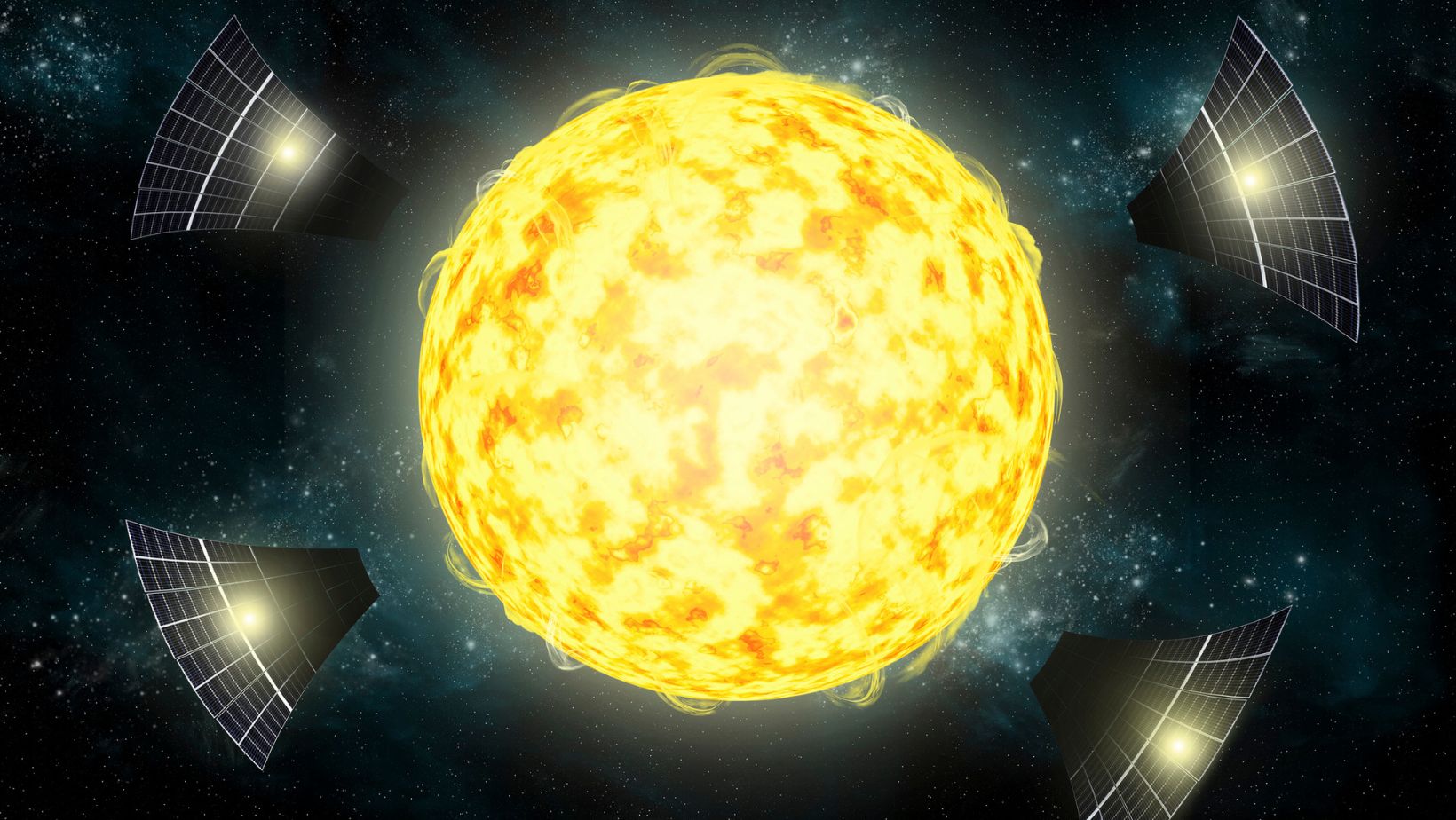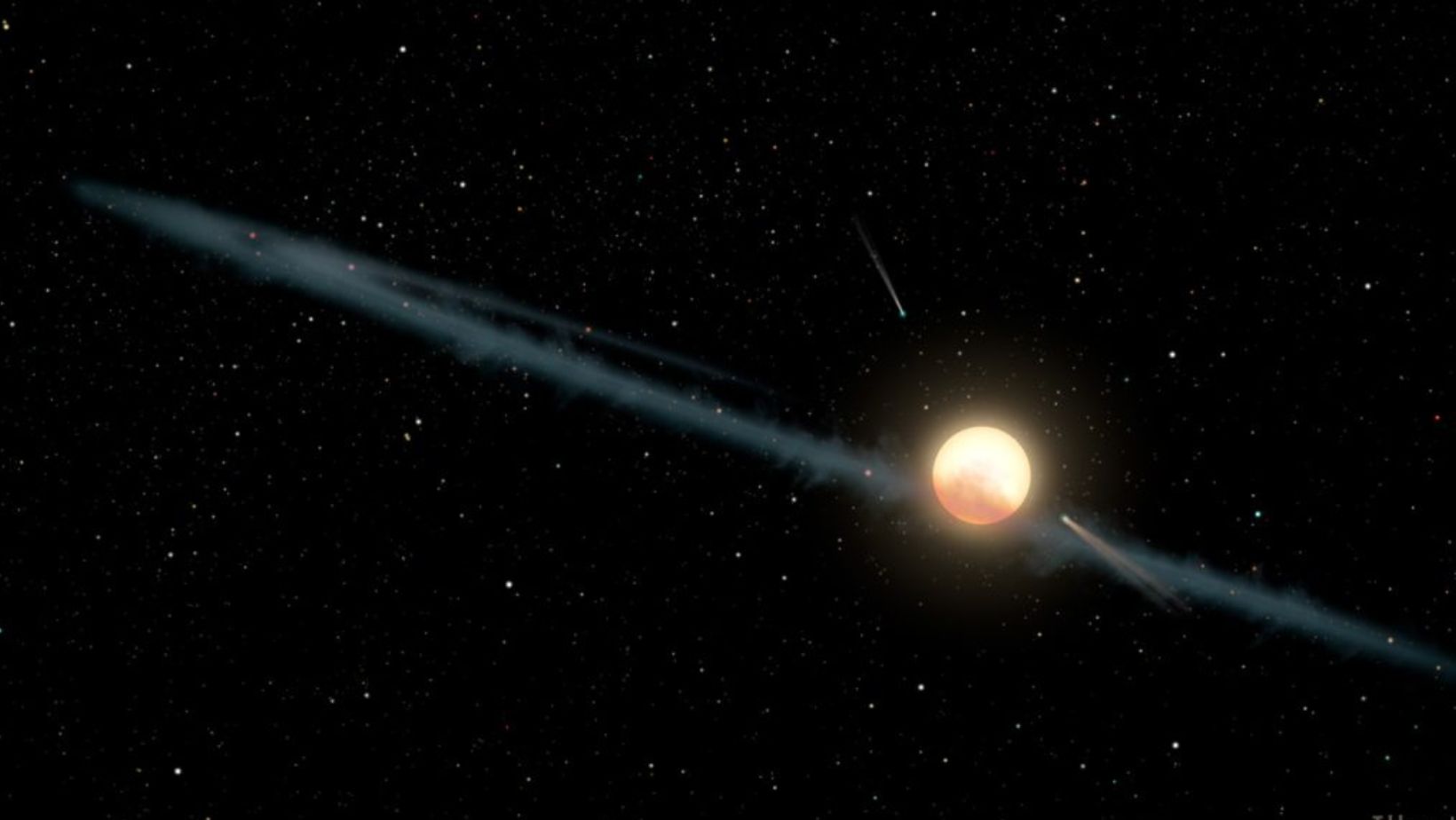Tabby’s Star, or KIC 8462852, has baffled astronomers since its discovery. Unlike any other star, it exhibits strange and unpredictable dimming patterns that defy explanation. Normally, stars fade in a predictable manner, but Tabby’s Star dips in brightness in an erratic way, sometimes by up to 20%. This mysterious behavior has sparked wild theories, from comet swarms to alien megastructures. But the truth behind these bizarre fluctuations remains a cosmic enigma. In this blog, we’ll dive into the mystery of Tabby’s Star, exploring the strange dimming and the theories that try to unravel its secrets.
What is Tabby’s Star?

Tabby’s Star, officially known as KIC 8462852, is a mysterious and unusual star located in the constellation Cygnus, about 1,480 light-years away from Earth. It is a main-sequence star, similar to the Sun, but exhibits strange dimming patterns that have puzzled astronomers since its discovery. Over time, the star’s brightness fluctuates in irregular and significant ways, far more than typical stars. These dips have been observed by NASA’s Kepler space telescope and are unlike anything seen in other stars.
The main characteristic of Tabby’s Star is its unpredictable dimming behavior. At times, it dims by as much as 20%, which is far beyond the usual dimming caused by planets passing in front of stars. This unusual pattern led to numerous theories, ranging from comets or dust clouds to more speculative ideas, such as the presence of alien megastructures. While no conclusive explanation has been found, scientists continue to study the star to better understand its behavior.
Tabby’s Star has captured the interest of astronomers because of these oddities. Its unexplained light fluctuations challenge current models of stellar behavior. Researchers are eager to determine whether these dips are caused by natural phenomena or something more extraordinary. The mystery surrounding Tabby’s Star continues to fuel curiosity and drive ongoing research in astrophysics.
The Strange Dimming Behavior
Astronomers have observed an unusual dimming pattern in certain stars that does not align with typical stellar behavior. This dimming, known as “dipping,” occurs when a star’s brightness fluctuates unpredictably, sometimes by large amounts. Unlike normal stars, which have consistent brightness levels or follow predictable patterns, these stars experience erratic drops in light, often lasting from hours to days. The cause of this strange dimming remains a mystery, but it has sparked significant interest in the astronomical community.
In typical stellar behavior, stars maintain steady luminosity, with some variation due to natural cycles like sunspots. However, the dimming observed in these stars is much more extreme, resembling eclipses or transits of planets in front of them. In some cases, the dimming can be repeated or appear in cycles, which is unlike most stellar phenomena. Scientists are still working to understand whether these anomalies are caused by external objects, star activity, or other unknown factors.
Possible Natural Explanations
Dust clouds and debris in a star system can block or scatter light, creating unusual dimming patterns. These materials may originate from planetary collisions or leftover debris from star formation. As the dust moves, it alters the star’s brightness, mimicking mysterious phenomena. Astronomers often study this possibility to rule out more exotic explanations.
Comets passing near a star can also explain irregular dimming. Large cometary tails reflect or absorb light, causing temporary dips in brightness. A swarm of comets could produce repeating patterns as they orbit the star. This theory is considered when other natural causes are unlikely.
Exoplanets, or planets outside our solar system, might play a role in brightness changes. When they transit across their star, they block some light, causing predictable dimming events. Unusual orbits or clusters of exoplanets could create irregular patterns. Such behavior often points to complex planetary systems.
These natural explanations are crucial for understanding stellar behavior. They guide researchers in solving puzzles without jumping to conclusions. Scientists use advanced tools to detect dust, comets, or exoplanets around stars. This helps ensure that observed phenomena are rooted in known physics. By analyzing these possibilities, astronomers gain deeper insights into star systems.
The Alien Megastructure Hypothesis

The Alien Megastructure Hypothesis suggests that advanced extraterrestrial civilizations could build massive structures around stars to harness their energy. One proposed example is the Dyson Sphere, a hypothetical structure that captures a star’s energy output for power. These megastructures might completely or partially encase the star, creating a unique energy signature. Scientists first theorized this concept in 1960, inspired by Freeman Dyson’s idea of advanced energy solutions.
A Dyson Sphere or similar megastructure represents technological advancement far beyond humanity’s capabilities. It could take forms such as a solid shell, a swarm of satellites, or a reflective ring. Each design focuses on capturing stellar energy to support planetary-scale needs or interstellar projects. Such a structure would be highly detectable through specific light patterns it emits or blocks.
Scientists find this hypothesis intriguing because of unusual signals from distant stars. In 2015, KIC 8462852, or Tabby’s Star, exhibited strange, irregular dimming patterns. These fluctuations did not match natural explanations, sparking speculation about megastructures. While no evidence confirms this yet, it shows how scientists consider all possibilities in their search for extraterrestrial life.
Although still speculative, the hypothesis broadens our perspective on life’s potential across the universe. It challenges us to imagine what advanced civilizations might achieve.
Technological Hints: Could Alien Civilizations Be Involved?
The Search for Extraterrestrial Intelligence (SETI) explores the possibility of alien civilizations. It scans the cosmos for signals or patterns suggesting intelligent life. Scientists focus on narrow-band radio waves and laser pulses, which may serve as communication tools. These methods aim to detect signs that natural phenomena cannot explain.
Speculations about alien technology often imagine capabilities far beyond ours. Advanced civilizations could harness energy from stars, creating detectable megastructures like Dyson Spheres. Unusual anomalies, such as dimming stars or unexplained bursts of energy, fuel these theories. Such possibilities inspire ongoing efforts to find extraterrestrial technology.
SETI also considers alien motives for sending signals. They might wish to communicate or leave evidence of their existence. Alternatively, they may not communicate intentionally, and we could stumble upon their technology by accident. This adds layers of intrigue to the search.
While no definitive proof exists, efforts continue with optimism. Technological advancements improve our detection capabilities. Breakthroughs in telescope resolution and AI analysis refine the search. The question of alien involvement remains open, inviting curiosity and exploration.
The Impact of Tabby’s Star on Popular Culture

Tabby’s Star, also known as KIC 8462852, has captured public imagination since its discovery. Its mysterious dimming pattern led some to speculate about alien megastructures. This sparked widespread media coverage, fueling curiosity and debates. The intrigue elevated it from a scientific mystery to a cultural phenomenon.
Movies and TV shows have incorporated themes inspired by Tabby’s Star. Science fiction productions often reference enigmatic stars and alien technology. Books exploring the unknown have also drawn parallels, weaving it into thrilling narratives. This highlights its role in shaping creative storytelling.
In social media, Tabby’s Star has become a topic of fascination. Memes, discussions, and speculative theories abound in online communities. Podcasts and documentaries delve into its scientific and imaginative aspects. This engagement shows its influence across various platforms.
Tabby’s Star demonstrates how science can inspire art and conversation. It bridges the gap between astrophysics and the public. Its mystery invites exploration, creativity, and wonder. This enduring fascination ensures its legacy in popular culture.
Challenges in Proving the Megastructure Theory
The Megastructure Theory suggests the existence of enormous artificial structures in space, such as Dyson Spheres. However, proving this theory is extremely challenging due to technological limitations. Current telescopes and observational tools lack the precision needed to detect or confirm these hypothetical constructs. This restricts scientists to analyzing faint or indirect evidence, such as unusual light patterns.
Another challenge is the vastness of space itself. Gathering detailed data on distant stars or systems requires immense resources and time. Even with advanced technology, factors like cosmic dust, interference, or natural phenomena can mimic the signals expected from megastructures. This makes distinguishing real megastructures from false positives very difficult.
Additionally, interpreting data relies on theoretical assumptions. Scientists base their models on what an alien megastructure might look like, which could be completely inaccurate. This adds uncertainty to observations and conclusions, making concrete proof elusive. Collaboration among global researchers is crucial to overcome these gaps.
Ultimately, the Megastructure Theory remains a fascinating hypothesis. It fuels curiosity about advanced civilizations and their capabilities. While proving it faces obstacles, advancements in technology and observational methods might one day provide the answers. Until then, it inspires further exploration of the universe.
What Do Recent Observations Suggest?
Recent astronomical observations reveal groundbreaking insights into our universe. Advanced space telescopes, like the James Webb Space Telescope, provide clearer images and detailed data. These tools uncover previously unseen phenomena, such as distant exoplanets and faint galaxies. They also offer a deeper look at the chemical composition of stars and nebulae.
One major finding includes the detection of water vapor on exoplanets within habitable zones. This suggests potential environments that could support life. Observations also show that black holes emit more energetic flares than previously understood. Such discoveries reshape theories about the formation and behavior of these cosmic giants.
Data collection is evolving rapidly with improved technology. Scientists now analyze infrared and ultraviolet light, giving a fuller picture of the cosmos. Artificial intelligence processes this data faster, helping identify patterns and anomalies. This approach allows astronomers to explore deeper regions of space with unprecedented detail.
These observations challenge old assumptions and fuel new questions. For instance, mysterious dark matter and energy remain central puzzles. Current studies aim to understand how they influence galaxy formation. As technology progresses, the secrets of the universe come closer to being unveiled.
Conclusion: Tabby’s Star: Could Alien Megastructures Explain Its Odd Dimming?
Tabby’s Star remains a captivating mystery, sparking curiosity about the possibility of alien life. While natural phenomena like dust clouds or cometary fragments are plausible explanations, the idea of extraterrestrial megastructures cannot be entirely dismissed. This uncertainty drives further exploration, urging scientists to refine observational techniques and gather more data. Future research, including advancements in telescopes and collaborations across disciplines, may provide clarity. Regardless of the outcome, Tabby’s Star underscores humanity’s quest to understand the universe and our place within it. Whether alien life is discovered or not, the journey enriches our knowledge and ignites a passion for discovery.
FAQs About Tabby’s Star: Could Alien Megastructures Explain Its Odd Dimming?
What makes Tabby’s Star different from other stars?
Tabby’s Star exhibits irregular and significant dips in brightness that do not align with typical stellar behaviors like planet transits or binary star systems. These unpredictable dimming events make it a unique and compelling mystery for astronomers.
Have other stars been observed with similar dimming patterns?
Yes, a few other stars exhibit somewhat irregular brightness variations, but Tabby’s Star is the most extreme example. The patterns observed in other stars are generally less pronounced or can be attributed to known phenomena, unlike the case with Tabby’s Star.
What role does dust play in explaining Tabby’s Star’s dimming?
Some scientists hypothesize that a cloud of dust particles orbiting the star could block light in a manner consistent with the observed dimming. The theory is supported by wavelength-dependent dimming, which suggests small particles rather than a solid megastructure.
How have scientists ruled out simpler explanations like a passing planet?
Planets cause periodic, predictable dips in brightness, which Tabby’s Star does not exhibit. The dips in Tabby’s Star’s light are irregular in timing and magnitude, making a single planet or even a group of planets an unlikely explanation.
Could future technologies help solve the mystery of Tabby’s Star?
Advanced telescopes and space observatories with improved sensitivity to faint objects and light variations could provide better data on Tabby’s Star. Additionally, breakthroughs in modeling and computational power might help simulate scenarios to narrow down plausible explanations.

